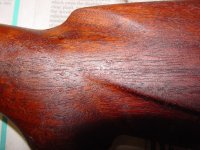Roughly 20 years ago I started building a 30-'06 rifle out of a Chilean Mauser. My career happened and I am going to finish that rifle now with a stock that was mostly sanded but is sticky, dull, and the grain is raised. Apparently I'm not smart enough yet to insert the attached image into this post. More homework...
So I'm starting with an unfinished Reinhart Fajen walnut stock with (as I recall) about 20 coats of what (I think) was boiled linseed oil. How do I proceed?
1. Sand and oil again?
2. Sand and use another finish?
3. Something else?
I remember someone telling me that if you start with oil you have to complete the job with oil... but I may have dreamed it. It was 20 years ago.
Ideas?
So I'm starting with an unfinished Reinhart Fajen walnut stock with (as I recall) about 20 coats of what (I think) was boiled linseed oil. How do I proceed?
1. Sand and oil again?
2. Sand and use another finish?
3. Something else?
I remember someone telling me that if you start with oil you have to complete the job with oil... but I may have dreamed it. It was 20 years ago.
Ideas?

